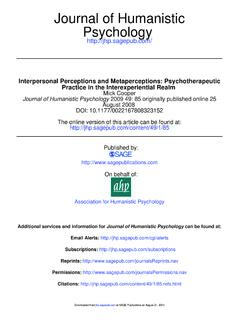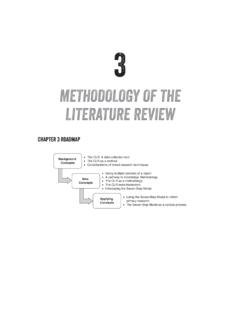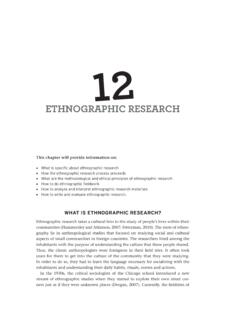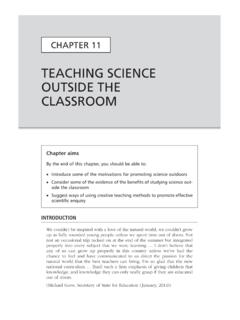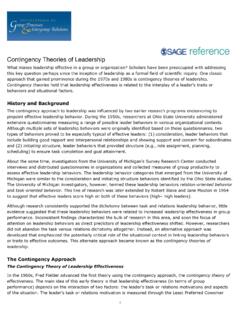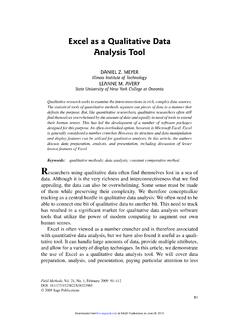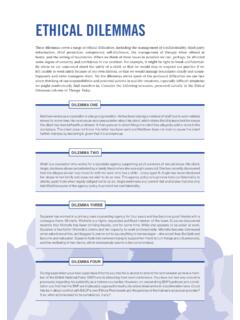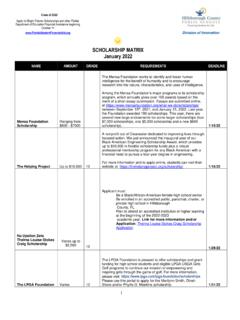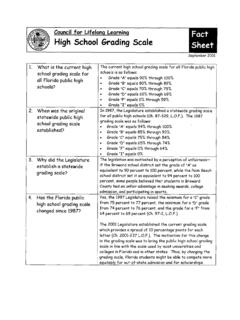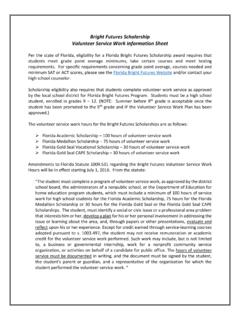Transcription of Encyclopedia of Criminological Theory
1 Encyclopedia ofCriminological TheoryChambliss, William J.: TheSaints and the RoughnecksContributors: Neil QuisenberryEditors: Francis T. Cullen & Pamela WilcoxBook Title: Encyclopedia of Criminological TheoryChapter Title: "Chambliss, William J.: The Saints and the Roughnecks"Pub. Date: 2010 Access Date: September 12, 2014 Publishing Company: SAGE Publications, : Thousand OaksPrint ISBN: 9781412959186 Online ISBN: 9781412959193 DOI: pages: 149-150 2010 SAGE Publications, Inc. All Rights PDF has been generated from SAGE knowledge. Please note that the paginationof the online version will vary from the pagination of the print 2010 SAGE Publications, Inc. All Rights knowledgePage 3 of 5 Encyclopedia of Criminological Theory : Chambliss,William J.: The Saints and the William Chambliss's 1973 groundbreaking study The Saints and the Roughnecks, he observed two groups of students from Hanibal High and showed how both socialclass and societal labeling led to one group being defined as delinquent while the otherwas defined as normal teenagers sowing a few wild oats.
2 In the 2 years that Chamblissobserved these teenagers, they were involved in activities such as truancy, drinking,wild driving, petty theft, and vandalism. The eight teenagers who were referred to as theSaints engaged in as much or more delinquent behavior than the Roughnecks, but theycame from middle-class homes and were able to avoid the deviant label. On the otherhand, the six Roughnecks came from lower-class households and were viewed by thecommunity as troublemakers. As a result, the futures of these young men were shapedby the labels they received while still in high the Saints were active in school affairs and athletics, Chambliss noted thatthey were some of the most delinquent boys at Hanibal High School. The Saints weresuccessful in school with grade point averages (GPAs) of an A or B but spent most daysmanipulating teachers to get out of school early. Once they were away from school,they could be found in a pool hall or caf in the suburbs. In neither of these placeswould the Saints likely be recognized by fellow the weekends, the Saints could most likely be found in Big Town, which was alarge city of over a million people 25 miles from Hanibal.
3 While in Big Town, the Saintswould drink heavily, drive drunkenly through the streets, commit acts of vandalism, andengage in pranks. They often moved construction signs and watched as motorists drovethrough pot holes or closed streets. The Saints were never seriously injured duringtheir weekend outings and were only stopped twice by the police, but never may be the result of the police believing that the Saints were good boys who werealways polite and contrite when the Saints, the Roughnecks were constantly in trouble with the police and thecommunity, although their rate of delinquency was essentially the same. However,the Roughnecks were different from the Saints in several important ways. First, theRoughnecks were not nearly as successful in school as the Saints. They had anaverage GPA of a C. They were not viewed as student leaders by their teachers,and they were not involved in school activities, although two were athletes. Second,SAGE 2010 SAGE Publications, Inc.
4 All Rights knowledgePage 4 of 5 Encyclopedia of Criminological Theory : Chambliss,William J.: The Saints and the Roughnecksthey engaged in delinquent activities in full view of the community. For example, theycould often be seen in front of the local [p. 149 ] drugstore just hanging around anddrinking. In addition, they were often in fights that were witnessed by the with drinking and fighting, they also engaged in the petty theft of such items aspaperback books, comics, and gasoline. The Roughnecks disliked the police and feltunfairly singled out. The police believed these were bad kids and attempted to arrestthem whenever there was evidence. As a result, each of the Roughnecks was arrestedat least once during the 2-year it came to the total number of illegal acts, the Saints were more delinquentthan the Roughnecks. However, the Saints were viewed by the community, teachers,and the police as good kids with bright futures. On the other hand, the Roughneckswere viewed as troublemakers and future criminals.
5 This was the result of severaldifferences between the two groups. The first difference was their respective levels ofvisibility. While the Saints had access to cars and were able to commit their delinquentactivities out of view of their community, the Roughnecks seldom had access to carsand therefore committed the majority of their delinquent activities in full view of theircommunity. Therefore, the delinquent activities of the Roughnecks were well-known tothe community, whereas the delinquency of the Saints was not. Another important factorthat led to the differential treatment of these two groups was their respective types ofdemeanor. While the Saints were apologetic and penitent when caught by the policefor their crimes, the Roughnecks reacted with hostility and disdain. More often than not,this led to the release of the Saints while the Roughnecks were arrested. Finally, therewas the issue of preexisting bias within the community regarding these two groups ofboys.
6 Although the Saints were viewed as good kids from middle-class families, theRoughnecks were viewed as bad kids from the wrong side of the a result of the differential labeling of the Saints and the Roughnecks, their outcomeswere different as well. While seven of the eight Saints went on to college after highschool, two of the Roughnecks went to college on athletic scholarships, two neverfinished high school, and two were sentenced to prison for murder convictions. Whileall but one of the Saints lived up to the high expectations the community had of them,the Roughnecks lived up to the community's expectations as well. The common beliefwas that the Saints would be successful individuals and, except for one, they other belief was that the Roughnecks would wind up as criminals, and except forSAGE 2010 SAGE Publications, Inc. All Rights knowledgePage 5 of 5 Encyclopedia of Criminological Theory : Chambliss,William J.: The Saints and the Roughneckstwo, they lived up to that expectation.
7 Chambliss concludes his study by suggestingthat selectively finding, processing, and punishing some kinds of criminality and notothers leads to the labeling of some as deviant and others as not, even while engagingin identical also Becker, Howard S.: Labeling and Deviant Careers Chambliss, William J.: Power, Conflict, and Crime Schur, Edwin M.: Radical Non-Intervention and Delinquency Turk, Austin T.: The Criminalization ProcessReferences and Further ReadingsBecker, H. (1963). Outsiders: Studies in the sociology of deviance . London: , W. J. The saints and the roughnecks . Society 11 (1) 24 31. (1973). , J. (2008). Ain't no makin' it: Aspirations and attainment in a low-incomeneighborhood (3rd ed.). Boulder, CO: Westview , J. (1998). The rich get richer and the poor get prison: Ideology, class andcriminal justice (5th ed.). Boston: Allyn & Bacon.
